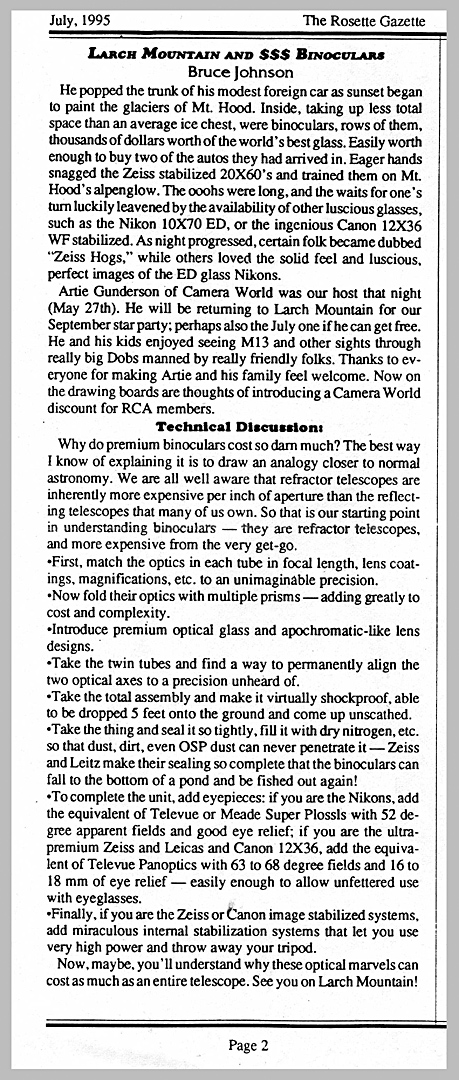

Performance under dim conditions: The old adage that mini size binoculars are "daylight" binoculars turns out to be pretty much true, even for the very highest quality of the minis. With 20-25mm of aperture, they are usable under dim conditions, but you'll find even the smallest "all-arounders" like 8x30s much more pleasing (I'm assuming high-quality and modern multi-coatings). "Dim conditions" include: a dark rainy day, a day getting close to dusk, inside a concert hall, or viewing a sports game at night "under the lights." All are conditions where the larger apertures, even if only 8x30 size, make a noticeable difference. "Under the lights" at a sports arena watching soccer was actually the least challenging, and both the Zeiss 8x20 and the Nikon 8x23 did fine.
Out on an open field in the country, as the day really dimmed down toward dusk, both of my high-quality minis continued to pull out details I would have thought impossible, yet when I pulled out my Zeiss 10x56s I was blown away-- with the big Zeiss, the scene's color and contrast just jumped right back out again, like turning on the lights! Back in 1995 on top of Larch Mountain at sunset, we witnessed the same effect of aperture-- the snow-clad peak had great alpenglow on it and naked-eye observers were admiring it... But ten minutes later the surroundings were really darkening down, and the naked-eye folks had stopped admiring the alpenglow because it looked basically gone--- but when the Nikon 10x70s were trained upon it, a chorus of "Wows" were once again elicted. The alpenglow was still pleasing through the luscious glass of the largest aperture binocular.
Copyright 2012 by Bruce B. Johnson
Back to Bruce's Oregon Star Party/Astro Main Page
The commonly-used descriptor "Wide-Angle" is a loose industry-standard measured by the technical parameter of a 60-degree wide "Apparent Field of View" (AFOV). If the binocular produces 60 degrees or more, it is legitimate to advertise it as a "Wide-Angle Binocular." Those of us who have peered through a large number of binoculars, however, have realized that not all "wide-angle" binoculars "feel" the same to the human eye/brain. There is a second factor that goes into producing a truly spectacular "wide-angle" experience.
Think of the IMAX screen at OMSI, and then remember the fact that some smaller, more modest theater venues take the same IMAX filmstrip and project it onto a much smaller, less-enveloping screen. Well, it's still "wide-angle," still shows all the content of the filmstrip, but it's "just not the same." The Awesome enveloping effect of true IMAX has been lost.
That's what the eyepieces and prisms of lesser-quality wide-angle binoculars do to the image-- they diminish it rather than enhance it.
The Best of the Best Binoculars in the World have an almost magical ability to somehow combine both a wide apparent field of view with an eyepiece construction and prisms that create, for lack of a better word, a VAST field of view. One your mind can "fall into," and roam around in at leisure. A big, broad FOV that really draws you in, catches your attention in a way that the lesser wide-angle binoculars simply fail to accomplish.
I've had the pleasure to own or use on extended use tests three such wide-angle binoculars: the Zeiss Night Owl 10x56 roof prism; the Nikon Venturer 8x42 roof prism; and the Swarovski 15x56,.also a roof prism... Of these, the Zeiss Night Owl was the most impressive. Each time you'd put it back up to your eye, you'd again have the sensation, "Wow, what a HUGE VIEW." On a lesser plane, but still impressive, was the Hensoldt 8x30 DF, an older military porro prism built by Hensoldt, the military optics division of Carl Zeiss West Germany. I mention it to point out that the "IMAX" type binoculars are not limited to the ultra-expensive, big, heavy models. Out of the Hensoldt's much smaller eyepieces came quite a comfortable, impressively big viewing experience.
Copyright Bruce B. Johnson 2010-2020
end